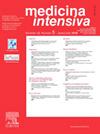Impacto de la oxigenoterapia a alto flujo a través de la insuflación de gas a alta velocidad sobre la fracción de engrosamiento diafragmático en sujetos sanos
IF 3.1
4区 医学
Q2 CRITICAL CARE MEDICINE
引用次数: 0
Abstract
Objective
The primary objective of this study was to evaluate the impact of high-flow nasal cannula oxygen therapy [HFNC] on the diaphragm thickening fraction.
Design
Prospective, descriptive, cohort study
Setting
The study was conducted in the Physiology and Respiratory Care Laboratory, Intensive Care Unit, Hospital Británico de Buenos Aires.
Participants
Thirteen healthy subjects >18 years old
Interventions
High-flow nasal cannula oxygen therapy
Main variables of interest
Demographic data (age and gender), anthropometric data (weight, height, and body mass index), and clinical and respiratory variables (Diaphragm thickening fraction [DTf], esophageal pressure swing, respiratory rate [RR], esophageal pressure-time product per minute [PTPes/min]).
Results
Median DTf decreased significantly as flow increased (P < .05). The baseline DTf measurement was 21.4%, 18.3% with 20 l/m, and 16.4% with 40 l/m. We also observed a significant decrease in RR as flow increased in HFNC (P < .05). In the 8 subjects with recordings, the PTPes/min was 81.3 cmH2O/sec/min (±30.8) and 64.4 cmH2O/sec/min (±25.3) at baseline and 40 l/m respectively (P = .044).
Conclusions
The use of high-flow oxygen therapy through nasal cannula of HFNC in healthy subjects decreases the DTf and RR in association with increased flow. In addition, the use of 40 l/m flow may reduce the muscular work associated with respiration.
通过高速气体充气进行高流量氧疗对健康受试者膈肌增厚率的影响。
目的本研究的主要目的是评估高流量鼻插管供氧疗法 [HFNC] 对横膈膜增厚分数的影响。设计前瞻性、描述性、队列研究环境本研究在布宜诺斯艾利斯不列颠医院重症监护室的生理学和呼吸护理实验室进行。参与者13名健康受试者>18岁干预措施高流量鼻插管供氧疗法主要关注变量人口统计学数据(年龄和性别)、人体测量数据(体重、身高和体重指数)以及临床和呼吸变量(膈肌增厚分数[DTf]、食管压力摆动、呼吸频率[RR]、每分钟食管压力-时间乘积[PTPes/min])。结果随着流量的增加,中位 DTf 显著下降(P <.05)。基线 DTf 测量值为 21.4%,20 升/米时为 18.3%,40 升/米时为 16.4%。我们还观察到,随着 HFNC 流量的增加,RR 明显下降(P < .05)。在 8 名有记录的受试者中,基线和 40 l/m 时的 PTPes/min 分别为 81.3 cmH2O/sec/min(±30.8)和 64.4 cmH2O/sec/min(±25.3)(P = .044)。此外,使用 40 升/米的流量可减少与呼吸有关的肌肉工作。
本文章由计算机程序翻译,如有差异,请以英文原文为准。
求助全文
约1分钟内获得全文
求助全文
来源期刊

Medicina Intensiva
CRITICAL CARE MEDICINE-
CiteScore
2.70
自引率
20.00%
发文量
146
审稿时长
33 days
期刊介绍:
Medicina Intensiva is the journal of the Spanish Society of Intensive Care Medicine and Coronary Units (SEMICYUC) and of Pan American and Iberian Federation of Societies of Intensive and Critical Care Medicine. Medicina Intensiva has become the reference publication in Spanish in its field. The journal mainly publishes Original Articles, Reviews, Clinical Notes, Consensus Documents, Images, and other information relevant to the specialty. All works go through a rigorous selection process. The journal accepts submissions of articles in English and in Spanish languages. The journal follows the publication requirements of the International Committee of Medical Journal Editors (ICMJE) and the Committee on Publication Ethics (COPE).
 求助内容:
求助内容: 应助结果提醒方式:
应助结果提醒方式:


